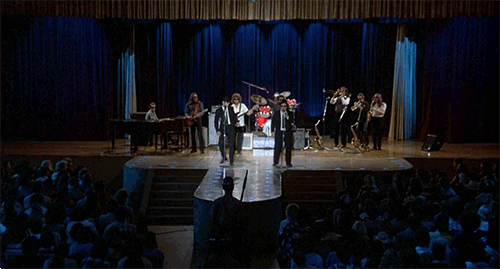CUNY is You, Me, Everybody
Jake and Elwood, brothers not by blood but by shared experience have a problem. The orphanage that brought them together as young boys and forever changed their lives is to be shut down. They need to raise five thousand dollars in eleven days to save the building that had housed them and provided a place for them to grow.
They don’t know what to do. So they go to church.
A rousing sermon is delivered by Reverend James. And in a shining moment of clarity, Jake has the answer. “The band.” Elwood at first does not understand. “The band?” Jake repeats, “The Band!” And then Elwood understands, “The Band!”
The band Jake and Elwood refer to is the rhythm and blues band they re-form in the 1980 fiction film The Blues Brothers. At this early point in the movie the audience doesn’t know what Jake, played by John Belushi, is referring to when he has his epiphany. They also don’t know how “the band” might possibly solve their problem in such a short time frame.
Over the remaining two hours of the film, Jake and Elwood crisscross Chicago convincing their old friends and band mates to put down what they are doing with their lives and get back together. Because if they do, they can perform. And people will come. And they can save the orphanage. Together.
I like to think of the early users of the CUNY Academic Commons as a group not unlike “the band”. And the people that built the Commons as the Blues Brothers. But most importantly the orphanage, they were trying to save was, is CUNY.
CUNY has an incredibly complicated history with City of New York, something I’ve learned a bit about in my work while surfacing old photos from the archives of many of the college’s libraries. The first CUNY school, now known as City College, was the “Free Academy.” Free as in no tuition, but also freeing in a sense that it was an opportunity for those to get a college education who previously could not. Hunter College, the second college was soon after founded for women. Subsequently City College and Hunter College created satellite campuses in Brooklyn which would eventually combine with the help of WPA money to found Brooklyn College.
Many more colleges followed of different types across all five boroughs and they were all free. There was no cost to the citizens of New York. They were open. CUNY became and remains the largest public urban university in the country. We have hundreds of thousands of students. Tens of thousands of faculty and staff. When someone I meet asks about CUNY, not knowing much about its history, one of the ways I like to describe it is by saying it’s a place for New Yorkers to get an education. All of them.
And until June of 1976, ending a 129-year old policy of charging no tuition, CUNY suddenly was no longer free. The city was in financial crisis and this was the only solution. A solution that continues to be seemingly the only answer in a time of perpetual financial crisis – a least for the public.
Now let’s be clear, I don’t believe that the people behind the CUNY Academic Commons thought that they were somehow going to come up with a solution to public education funding. And definitely not in eleven days. They did however have a belief that if they created a space for people from across a university to get together, something good would happen.
They built the Commons with a number of things in mind – what it would and would not be. The Commons would not be something everyone in CUNY was forced to use. It wouldn’t be perfect, and would need to be re-worked regularly with the input of its members that use it. It would be a place that allows its users to freely do what they wish with few restrictions – build sites, create groups to collaborate, share knowledge – basically trusting their judgement of their membership. It would be built on open-source software – free software – that is built by a development community much larger than CUNY. And because that development community depends on users of the software to contribute back what they’ve learned, we would share back our knowledge with them.
And the Commons would be open to the public. So that the people of this city and beyond could see what CUNY is through the kind of work that the faculty and staff do. And the public, having the opportunity to more directly engage the university, might have a better understanding of its value.
In the few years since the Commons was created there are now 4,000+ faculty, staff, and graduate students that have joined. Together they have created 500 groups to collaborate and do work. There are almost a thousand blogs on which they reflect on their process in the academy. And their willingness to present themselves in this open forum hopefully serves as a reminder to the public as to why they/we believe in a public education.
To illustrate who and what CUNY is, I present to you a member of the Commons, Amrita Dhawan, a librarian at City College who is working to make connections between high school seniors and college freshman. Also, there is the CUNY Games Network a group on the Commons that has been engaging the university with innovative pedagogies. Their efforts have recently culminated in the University’s first ever CUNY Games Festival, a conference to promote and discuss game-based learning in higher education. And then there is a Graduate Center course being conducted in the open that invites all of us to simply consider who we are by asking us to better understand how we construct an image of the self.
These examples were selected from a quick snapshot of the ‘activity stream‘ of the Commons, which I believe provides a glimpse of what a public university in action actually does.
“CUNY is…” was a particular ad campaign used by the University a few years ago that inserted the name of a celebrated faculty member after the phrase. You would see them on subway posters and on website banner ads that displayed an image of the university as an opportunity to study with the acclaimed. These faculty deserve recognition, but to sum up that ‘CUNY is’ just these individuals does not do justice to the work of so many more.
I believe that the Commons does do justice to represent all of CUNY and efforts of the people that make up that institution. They are working to preserve the trust with the public to provide its citizenry with an opportunity to get an education. Not for the few, but for everyone.
When we discovered CUNY.is as a clever short URL we could use as a quick link to share the work being done on the Commons, we were also reclaiming that ad campaign’s message for all of CUNY. Because CUNY is You, Me, Everybody. Everybody.





Trackbacks/Pingbacks
[…] for the CUNY Academic Commons blog Ground Control as a project team member contribution. It was published last Friday, and wanted to republish it on my personal blog because I love the Commons, CUNY, and the Blues […]